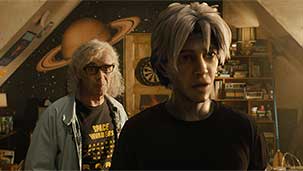You are credited with creating the first widely recognized video game Easter egg – an intentional secret feature, usually an inside reference of some kind, programmed into a game by the designer for the player to "hunt" for. Over time, Easter eggs have become more complex, with many including secret levels, messages, and other mini-games within the game.
Now we get Ready Player One – an inside joke, wrapped in a reference, inside an Easter egg. A giant, obvious, CGI one. Watching it is kind of like eating handfuls of actual Easter eggs –it feels good while you’re doing it, but after the sugar coma subsides, you crave real substance.
Following my screening, while still buzzing from the spectacle, the guy sitting next to me gleefully announced to his seatmate, "the references were the best part!" The references –Back to the Future, The Shining, Godzilla, Iron Giant, and on and on ad infinitum – are the framework upon which the narrative relies. This is no surprise to anyone who read the novel the film is based on. I read it when it debuted in 2011 and enjoyed the dystopian futuristic fantasy and fizzy, late 20th century nostalgia trip that it is. Now though, after the toxicity of Gamergate, sitting through every rote Stan Lee cameo, and being thrilled by films like Wonder Woman and Black Panther, Ready Player One already feels stale and retrograde.
That’s not to say Ready Player One isn’t a fun, edge-of-your-seat action-extravaganza. It definitely is. But that’s pretty much all it is. And maybe that’s all it aspires to be. But expecting audiences to embrace yet another dimensionless white boy protagonist whose skills are limited to knowing which high school Ferris Bueller went to and how to play retro Atari games like Adventure, and whose sole motivation is to "get the girl" just doesn’t hold much water any more. If it ever did.
Ready Player One is set in slum-like, dystopian Ohio in 2044, where people escape their dreary existence by plugging into the OASIS, a virtual reality world where they can be anyone or anything they want. The OASIS was created by a milquetoast genius named James Halliday who upon his death, bequeathed his trillion dollar fortune to anyone who can find the numerous Easter eggs he has hidden within OASIS. In order to do this, Gunters (short for "Egg Hunters") must study Halliday’s life and the things he loved – namely 80’s pop culture. Enter Wade Watts, a teen boy intent on solving Halliday’s puzzles and winning his fortune in order to live a life of luxury. It isn’t until he meets a girl with a hot avatar named Art3mis (who, by the way, is just as skilled as he is), that he decides to join her fight to win Halliday’s fortune in order to keep it out of the hands of IOI, an evil corporation looking to exploit OASIS for its own greedy agenda.
This film was never going to be easy to adapt. With Steven Spielberg at the helm, it raised expectations, specifically because Ready Player One requires his kind of world-building virtuosity. Spielberg’s adaptations are at their best when they ground their high-concept in humanity, which he does masterfully in films like Jaws, Jurassic Park, and Minority Report to name but three. He puts his flawed characters into extraordinary circumstances and lets us watch them grow. There is no such growth here. Wade, and his rag-tag band of Gunter friends, are not compelling characters. They are cyphers – an 80s reference delivery system designed only to push the story towards its obvious conclusion. Set pieces that revolve around an Easter egg hunt in the Overlook Hotel from The Shining, and a race through a virtual city starring a souped-up version of Marty McFly’s DeLorean are fun to watch, but seem to exist solely with the intent of giving the audience the smug satisfaction of nodding knowingly to themselves and saying, "I got that reference".
Nostalgia, in and of itself, is a self-indulgent exercise – just ask Tom Cruise’s character in Minority Report. When practiced in moderation, nostalgia can be a cathartic and uplifting experience – hearing a song or seeing an ad for a movie from one’s childhood gives us that momentary glow of remembering a simpler time. But the 80s weren’t so simple. Recalling the circumstances surrounding a particular childhood reference – like how Rocky IV was a direct result of the often terrifying Cold War, how the song "Sun City" was about Apartheid, and that so many people who gave us our favourite songs, films and works of art, like Rock Hudson, Keith Haring and Freddie Mercury, died of AIDS – is a critical by-product of nostalgia and how it gives us a deeper sense of who we are and where we came from. Seeing a neon "Cocktails & Dreams" sign, or a "Goldie Wilson for Mayor" poster, without any context or explicit connections to the characters isn’t world-building, its set dressing.
The Easter egg existing for its own sake isn’t the point. It’s the humanity behind it that makes it special - knowing that there was a person communicating with you from inside the game. Ready Player One, despite its pedigreed director, amiable cast, and eye-popping visuals, mistakes tired references and slick action sequences for personality, and in doing so reveals itself to be ultimately hollow.
Sincerely,

Di







